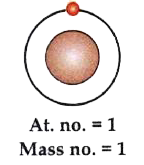Which sub-atomic particle was discovered by
Chadwick.
Step-by-Step Solution:
1. Identify the Scientist: The question asks about the sub-atomic particle discovered by Chadwick. The scientist in question is James Chadwick.
2. Understand the Experiment: Chadwick conducted an experiment where he bombarded alpha particles onto a boron film. This experiment was crucial in his discovery.
3. Observation of Rays: After bombarding the boron film, Chadwick observed rays that were neutral in nature, meaning they had no electric charge.
4. Further Testing: To investigate these rays further, Chadwick passed them through a wax-like structure.
5. Ejection of Protons: When the neutral rays struck the wax, they caused protons (positively charged particles) to be ejected from the wax.
6. Conclusion on Mass: Chadwick concluded that the rays had a significant mass, enough to eject protons, and he deduced that the mass of these rays was equal to the mass of protons.
7. Naming the Particle: Based on his findings, Chadwick named the newly discovered particle "neutron" due to its neutral charge.
Final Answer: The sub-atomic particle discovered by Chadwick is the neutron.
---
Topper's Solved these Questions
- ATOMIC STRUCTURE AND CHEMICAL BONDINGBOOK - ICSECHAPTER - ATOMIC STRUCTURE AND CHEMICAL BONDINGEXERCISE - EXERCISE 4(B)
12 Videos
- ATOMIC STRUCTURE AND CHEMICAL BONDINGBOOK - ICSECHAPTER - ATOMIC STRUCTURE AND CHEMICAL BONDINGEXERCISE - EXERCISE 4(C)
54 Videos
- ATMOSPHERIC POLLUTIONBOOK - ICSECHAPTER - ATMOSPHERIC POLLUTIONEXERCISE - EXERCISE 8(D)
38 Videos
- CHEMICAL CHANGES AND REACTIONSBOOK - ICSECHAPTER - CHEMICAL CHANGES AND REACTIONSEXERCISE - EXERCISE 2(C)
30 Videos
Similar Questions
Knowledge Check
Which atomic particle has negligible mass?
AprotonBelectronCneutronDboth proton and neutronWhich of the following statements is incorrect? Bohr gave theory of hydrogen atom and, Yukawa gave theory of nuclear forces. Law of gravitation was discovered by Newton and principle of intertia by Galileo. Laws of photoelectric effect were discovered by Einstein and laws of electromagnetic induction by Faraday. Neutron was discovered by J.J. Thomson and electron was discovered by James Chadwick.
ABohr gave theory of hydrogen atom and, Yukawa gave theory of nuclear forces.BLaw of gravitation was discovered by Newton and principle of intertia by Galileo.CLaws of photoelectric effect were discovered by Einstein and laws of electromagnetic induction by Faraday.DNeutron was discovered by J.J. Thomson and electron was discovered by James Chadwick.
Which part of atom was discovered by Rutherford.
View SolutionDescribe Thomson's plum pudding model. Which subatomic particle was not present in this model of the atom?
View SolutionThe diagram represents an isotope of hydrogen (H). Answer the following:
Which sub-atomic particles in the 3 isotopes of 'H' are the same.

View SolutionName the sub-atomic particle whose charge is :
+1
View SolutionName the sub-atomic particle whose charge is :
-1
View SolutionName the sub-atomic particle whose charge is :
0.
View Solution
